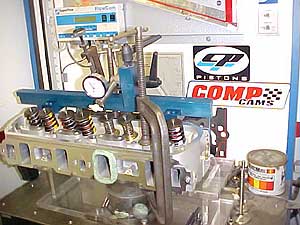Project Muscrate
Part 2: Head games
by Jay Roeder
www.roederperformancemachine.com
2/12/04
Hi everyone, it's time to get to work. This installment of Project Muscrate will cover the cylinder heads that I am using, and what can be legally modified, as per IHRA rules, to increase performance, meaning flow.
 The
302/320 hp Ford crate engine comes from Ford with a pair of GT-40 Turbo Swirl
aluminum cylinder heads. Now before anyone gets too excited, the only thing
"turbo" about these heads is the name. In fact, they are moderate street/strip
style heads with rather uniquely shaped combustion chambers designed to promote
"swirl" within the chambers and provide a more efficient burn during combustion.
The
302/320 hp Ford crate engine comes from Ford with a pair of GT-40 Turbo Swirl
aluminum cylinder heads. Now before anyone gets too excited, the only thing
"turbo" about these heads is the name. In fact, they are moderate street/strip
style heads with rather uniquely shaped combustion chambers designed to promote
"swirl" within the chambers and provide a more efficient burn during combustion.
That being said, what do they flow, you ask? The answer is, not as much as they are supposed to. The problem with flow numbers from all manufacturers is they tend to be way too optimistic about the published flow numbers of a particular head. The problem for me, as an engine builder, is that I have a SuperFlo computerized flowbench and I know the truth about what a head flows at a given lift at a given pressure drop. I am continuously aggravated.
For instance, I have just completed a 406 SBC customer engine that I used aftermarket iron heads on. When I initially planned this guy's project, I looked at the advertised flow numbers for these heads -- 307 cfm at 28 inches of pressure drop. Knowing how things usually work, I figured that in the real world they would probably flow about 25 cfm less than advertised. WRONG! How does 262 cfm at 28 inches strike ya? That's 45 cfm less than advertised! You have to watch these things.
My heads for the Muscrate engine, on the other hand, were supposed to have an intake flow of 240 cfm at .550" lift at 28 in. drop and the exhaust numbers were advertised at 170 cfm at .500" lift. In the real world however, (on my SuperFlo bench) they peak out at 221 cfm intake @ .600" lift and the exhaust peaks at 141.30
|
ADVERTISEMENT  |
The main piece of advice I would give to the consumer when trying to decide which pair of aftermarket cylinder heads to choose, is to seek the advice of a reputable engine builder and ask if they have ever flowed the particular heads you are interested in. Also, keep in mind that PEAK flow numbers are almost meaningless. Peak flow is a number that some people like to throw out during the deep discussions we all have had about our favorite thing, horsepower. The person that has the best mid-lift flow and average flow is always going to be the winner in the real world.
HEY, THERE'S AN MSD UNDER MY SEAT!
Again, let's visit my front-engine dragster for a quick Pit Tip. I credit chassis man Harris with this idea.
We were searching for just the perfect place to mount our new MSD Digital 7-Plus ignition box, a box that is about as wide and as long as a folded piece of paper. Now, this is one trick piece. According to MSD's media relations man, Todd Ryden, the box is outfitted with rotary dials, making it easy to set various rpm controls either by a turn of the screwdriver or a twist of your fingers. The MSD Digital 7-Plus has two rev limiters -- a low side, for starting line launches and a high side, for over-rev engine protection -- that can be set at hundred-rpm increments. There is also a built-in stage of retard, for single-stage nitrous shot applications, and a retard for starting, Ryden said.
Now, let's get specific to Muscrate's cylinder heads. The heads out of the box are actually not too bad for a mild performance application and if allowed by the rules could probably benefit quite a bit from some pocket porting, bowl blend, unshrouding of the valves in the combustion chamber and a nice gasket match. Problem is, that would be ILLEGAL! You see, the IHRA and NHRA have some very specific rules and specifications of what you can and (mostly) cannot do to heads intended for Stock Eliminator duty. Basically, NO porting, polishing, welding, epoxying, valve unshrouding, or any other common form of head modification is allowed.
Also, the stock size valves and stem diameter must remain and no titanium or hollow stems are allowed. The valve springs have to be the same type (single for single, etc.) as what would have come on the heads from the factory, and must use a stock diameter retainer.

So, here is what you CAN do. In the photos you can see a before and after of the intake and exhaust valves. It is sometimes amazing how well a head responds to a simple back-cut of the valves. Also, I have found that most exhaust valves respond well to gently radiusing the leading edge of the margin where it transitions from the face of the valve. The trick to all this is countless hours of trying various angles and widths of the back-cut and then FloBench testing every modification. Even the amount of radius on the exhaust valve effects flow.
|
||||||||||||||||||||||||||||||||||||||||||||||||||||||||||||||||
What's the pay-off for all this work? As the flowchart shows, about 4 cfm average on the intake and 5 cfm average exhaust. Seems hardly worth the effort, I know, but those numbers don't tell the whole story. If you look closely, at .100" lift on the intake, the flow improved 7 cfm and at .200" lift we see a gain of 10 cfm. The exhaust faired even better at .100" lift with a very nice gain of 12.4 cfm, and at .200" another 13 cfm was gained. Not too bad for JUST valve work.
Also, you will notice a loss of flow at .500" lift on the intake of about 2 cfm and a 3 cfm loss at .600" lift. It doesn't matter when the maximum valve lift of my camshaft is limited to .498" by IHRA for the 320hp/302.
So, what does all of this work end up getting for a horsepower gain? Probably about 10 hp at 7,000 rpm and an average of around eight hp throughout the usable rpm range. Doesn't sound like much to most people outside of the "Stocker Wars," but considering all the rules involved, I'll take that 10 hp any day.
In the next article, I will try not to be so long-winded and get to the fun stuff. I just wanted to give you readers of Drag Racing Online a little closer look at the trials and tribulations of what a "class racer" goes through in the search for the edge you may need on the next heads-up race that comes your way. You did know that on occasion "Stockers" have a heads-up, whoever-gets-there-first race, right? Why else would we subject ourselves to this self-inflicted abuse?
When in doubt, DO A WHEELIE!
Copyright 1999-2004, Drag Racing Online and Racing Net Source